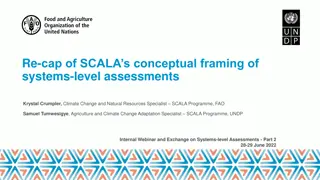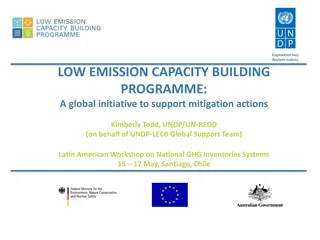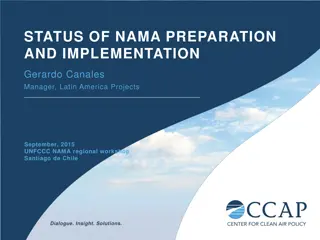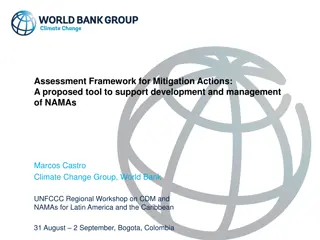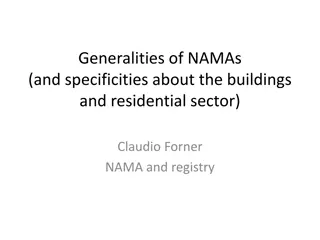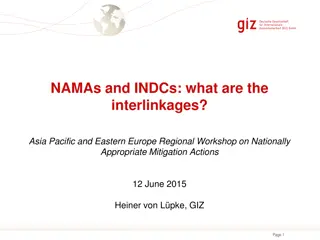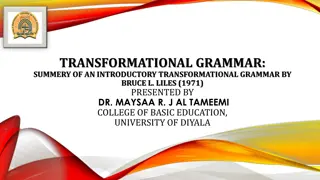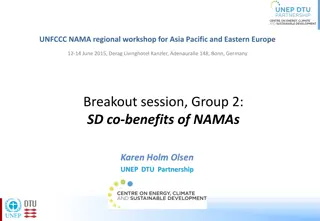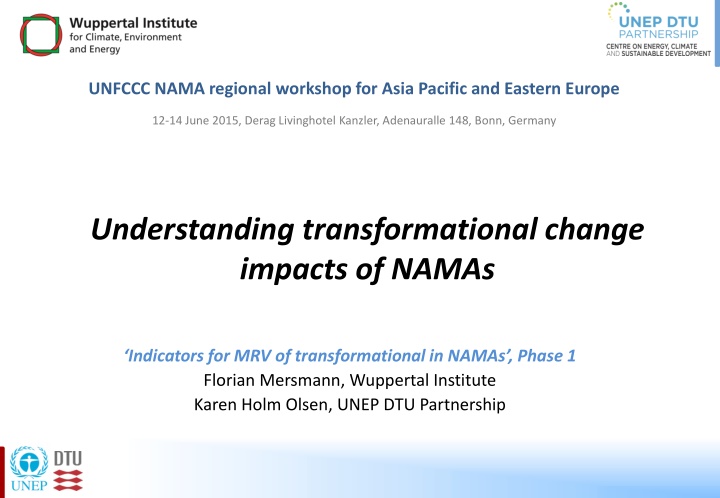
Assessing Transformational Impacts in NAMAs
Objectives and methodologies for assessing transformational change in Nationally Appropriate Mitigation Actions (NAMAs) are discussed in this research project, focusing on understanding, monitoring, reporting, and verifying low-carbon development initiatives. The aim is to facilitate sustainable development towards the 2°C target through innovative approaches and case studies. The paper explores the concept of transformational change within the context of NAMAs, emphasizing the importance of disrupting established high-carbon pathways and overcoming barriers to sustainable transformation.
Download Presentation

Please find below an Image/Link to download the presentation.
The content on the website is provided AS IS for your information and personal use only. It may not be sold, licensed, or shared on other websites without obtaining consent from the author. If you encounter any issues during the download, it is possible that the publisher has removed the file from their server.
You are allowed to download the files provided on this website for personal or commercial use, subject to the condition that they are used lawfully. All files are the property of their respective owners.
The content on the website is provided AS IS for your information and personal use only. It may not be sold, licensed, or shared on other websites without obtaining consent from the author.
E N D
Presentation Transcript
UNFCCC NAMA regional workshop for Asia Pacific and Eastern Europe 12-14 June 2015, Derag Livinghotel Kanzler, Adenauralle 148, Bonn, Germany Understanding transformational change impacts of NAMAs Indicators for MRV of transformational in NAMAs , Phase 1 Florian Mersmann, Wuppertal Institute Karen Holm Olsen, UNEP DTU Partnership
Outline: Objectives of the research project: Indicators for MRV of transformational change in NAMAs Understanding TC in NAMAs Case studies of low carbon and sustainable development Towards a methodology for assessment of TC potential in NAMAs Questions/Discussion
Assessing TC in NAMAs Objective: To improve the understanding of transformational change (TC) and how to Monitor, Report and Verify (MRV) Nationally Appropriate Mitigation Actions (NAMAs) that may facilitate TC for low emission and sustainable development to achieve the 2 C target Phases and outputs: Phase 1: Understanding transformational change Output 1: Conceptual paper Output 2: Case studies Phase 2: Methodological framework Output 3: NAMA TC taxonomy Output 4: Test of tool to 98 NAMAs submitted to UNFCCC Registry by 1 May 2015
Aim and content of the conceptual paper The aim of the paper is threefold: o To provide first and general insights into the meaning of Transformational Change o To compile a number of theoretical approaches that could be used for assessment of transformational impacts o To develop theses to guide the case studies Starting point: Defining transformational change through NAMAs Transformational Change through NAMAs is a change 1. that disrupts established high-carbon pathways, contributes to sustainable development and sustains the impacts of the change (goal dimension), 2. that is triggered by interventions of actorswho innovate low carbon development models and actions, connect the innovation to day-to-day practice of economies and societies, and convince other actors to apply the innovation to actively influence the multi-level system to adopt the innovation process, (process dimension) 3. that overcomes persistent barriers toward the innovated low carbon development model and/or create new barriers which hinder the transformed system to relapse into the former state ( low- carbon lock-in ).
NAMAs for Transformational Change Sustainable Development Transformation to Low-Carbon Development NAMA Phase-out of BAU development pathways
Elements of transformational NAMAs Vision Transformational change starts with an ambitious vision of change. Experimentation and Innovation Transformational change involves risky decisions and investments that are not guaranteed to pay off. Governments can create the protected niches needed to experiment with new solutions. Actors and Coalitions Transformational change needs actors of change : innovators, disseminators, advocates, policy-makers.
Elements of transformational NAMAs (2) Instruments for Barrier Removal TC-NAMAs overcome persistent barriers. TC-NAMAs need policy instruments that are tailor-made to circumstance, in order to create a mix of push by markets and pull by policy. Systemic Change Transformational change needs to strike a balance between depth of change and connectivity to established practice (and habits) within society. For Transformational change, a portfolio of interventions is needed that together aim at change in all societal dimensions.
Transformational NAMAs: Layers of Change Systemic Change Instruments for Barrier Removal Actors and Coalitions Experimenta- tion and Innovation Vision
Aim and selection criteria for case studies The aim of the case studies is twofold: o To share experience and detailed accounts of success stories of transformational change o To inform the development of a methodological framework for assessment of transformational change potential in NAMAs based on the sustainability transition theories to learn, what are the empirically based indicators and success factors. Selection criteria: o The case studies are focused on successful (as to-date), planned, and country specific interventions with a view to achieve low carbon development o A balance in the choice between developed and developing country cases o The choice of cases must have a clear link to the hypothesized success factors/theoretical approaches selected o Countries with the most ambitious GHG reduction goals will be selected o Maximize the diversity of sectors (including one tackling LULUCF and one tackling transport) o The amount of cases studies will be kept at a maximum of five
Five case studies on TC Developed country perspectives: Germany: Energy system transformation - the role of laws and regulatory frameworks for renewable energy Denmark: The role of wind power towards 100% renewable energy in electricity production by 2050 Developing country perspectives: Brazil: The drivers of deforestation - a 75% drop over a decade (2005-2014) Columbia: Sustainable transport in Bogot the role of political will & technical solutions at city level South Africa: The role of state-owned companies to lead an incremental transition away from high-carbon lock-in to a low-carbon future
Comparison of key factors for TC Commonalities: Differences: Goals exist for GHG reductions and sustainable development Low-carbon lock-in is sustained by public opinion and national policies and laws Landscape trends and events at global level (e.g. nuclear accidents and oil prices) highly influence national transformations Transformational change is not managed by a single actor or intervention but happens over time in a system of competing interests Drivers of change processes How to overcome barriers for high- carbon lock-in The context for system change Historical phases of transformation Governance activities for management of transitions
Taxonomy for assessment of TC potential Dimensions Factors Indicators - based on questions to the cases What are the goal(s) and key indicator(s) of transformational change? Phases of transformation at what stage is the socio-technical system? Pre-development phase What are the established high-carbon pathways? Who are the pioneers of change? Operational definition of transformationa l change for low-carbon and SD Goal(s) of transformation Take-off phase What new ideas, concepts, coalitions, regulations and societal acceptance are emerging for low- carbon development? Process of change What intervention(s) trigger the change process? Who are the key actors? How will the intervention lead to system change? Acceleration phase How does policy and regulation support change? How does low-carbon solutions challenge established pathways? Is opposition to new solutions increasing or decreasing? Low-carbon lock-in Which barriers are overcome? How will a low-carbon pathway be sustained? Stabilisation phase Is the low-carbon pathway stable or at risk of relapse? What new barriers hinder relapse? Multilevel context for the socio-technical system transformed Landscape level What macro-level trends and changes in the socio-technical system have an impact on the transformation? Management of transformational change interventions a cyclic process of four governance activities Strategic How is the transition arena set up as the institutional core of an intervention in collaboration with a network of innovators? Regime level How is the socio-technical regime delineated? What established infrastructure and ways of doing things need to be changed with regard to rules, institutions, practices, behaviour, markets and industry structure? Tactical What are the driving sustainability and low carbon visions, agendas and pathways? How are actors mobilized for executing projects and experiments? Operational Niche level What new technologies or policies will trigger the transformational change? Do protected spaces exist for technical, social and organisational experiments and learning? Reflexive How does monitoring and evaluation of the transition process facilitate reflexive learning to modify and adjust transition goals and pathways? Interactions across levels What are the key dynamics of change between the three levels?



